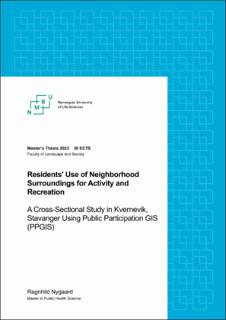| dc.description.abstract | Background: Our surroundings are fundamental for human health, well-being, and quality of life. The neighborhood environment includes various arenas used for different activities and recreational purposes. By using more advanced technologies and methods like Public Participation Geographic Information System (PPGIS), spatial analyses can provide a more comprehensive understanding about residents’ use of neighborhood surroundings to develop health-promoting environments.
Purpose: This study aims to examine residents’ use of their neighborhood surroundings for activity and recreational purposes in Kvernevik, Stavanger. Additionally, potential associations between sociodemographic factors, access to facilities and use of the neighborhood surroundings are explored.
Method: This cross-sectional study used data collected in the NORDGREEN project. The study employed a web-based Maptionnaire survey that combined conventional survey question with interactive map-based questions based on PPGIS methodology. QGIS 3.22 was used for the spatial analyses of the map-based data. The study sample consisted of adult residents (>18 years) living in Kvernevik with marked home locations (n=326). Associations between sociodemographic factors, access to environmental qualities and use of the neighborhood surroundings were examined using linear regression models.
Main findings: Participants marked an average of 2.3 locations in the neighborhood. The marked places (n=553) were everyday activity and recreational places (ARP) and favorite places (FP). Land use characteristics of the ARP and FP differed significantly with FP being located more frequently in green spaces and less frequently in residential areas. Participants with higher education marked significantly more places compared to those with lower education, and those with no minors or no children travelled significantly farther distances to their marked locations compared to those with younger children. No other significant differences between the sociodemographic groups were observed. Access to certain facilities like playgrounds, everyday facilities, and forests and rocky areas, were significantly associated with the number of mapped places and/or the distance parameters.
Conclusion: The results of this master thesis indicate differences in how people use their neighborhood surroundings for activity and recreation, both in general and among various sociodemographic groups. Additionally, access to certain facilities seems to influence usage patterns. Policymakers, urban planners, and public health professionals should consider these findings when developing activity-friendly and health-promoting neighborhoods. | |
